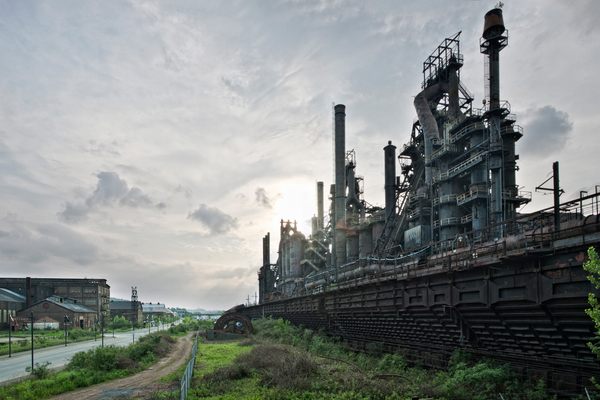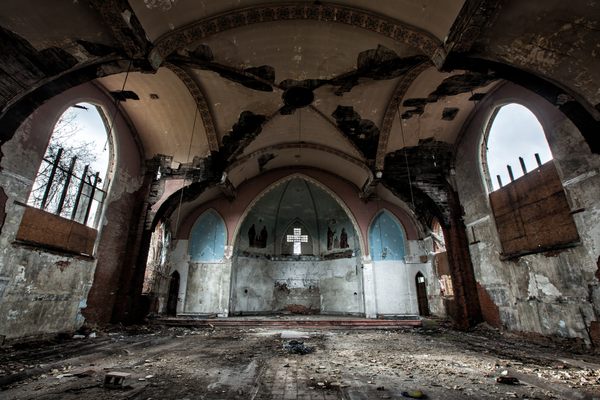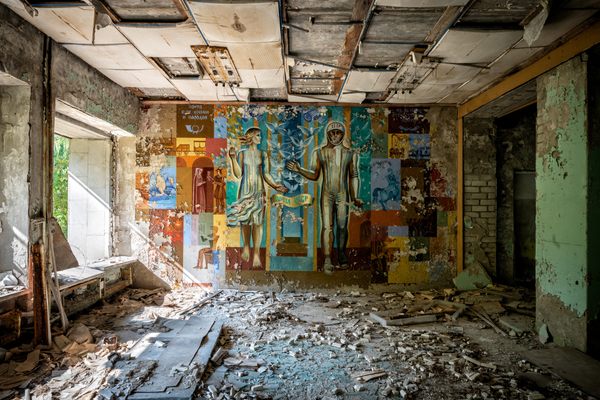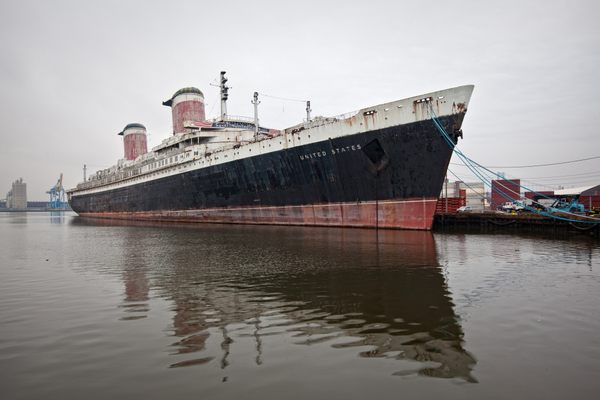
What Can We Learn From the Ruins of Gary, Indiana?
Exploring deindustrialization.

It’s hard to imagine how a building as grand as the City Methodist Church in Gary, Indiana, could ever become abandoned. Completed in 1926, the spectacular nine-story complex also included, at one time, a 1,000-seat theater, offices, a dining hall, and a gymnasium. Built at a cost of over $800,000—equivalent to over $14 million today—City Methodist served more than 3,000 congregants at its peak before dwindling attendance and lack of funds led to its closure in 1975. Today, ivy cascades like a waterfall through its broken stained glass windows, the sagging remains of the choir loft clinging desperately to the wall.
You can imagine it as the ruins of an abbey, painted by a famed Romantic artist, hanging on the wall of an art museum. But unlike the forlorn chapels and cathedrals of the English countryside, popularized in picturesque art from the late 1700s, City Methodist was built less than a century ago. The city surrounding it, also in shambles, isn’t much older. The heavens visible through City Methodist’s collapsed roof evoke a sense of the timeless and eternal, in stark contrast to the graffiti adorning the walls and the sounds of traffic outside. Gary is a city of modern American ruins created by distinctly contemporary problems, with City Methodist as perhaps the most iconic and enduring symbol of its loss and, some might argue, its betrayal.


The first thing one observes on driving through Gary today is just how many vacant buildings there are. According to an article in USA Today, in 2019 nearly 20 percent, or roughly 5,700, of the single-family homes in Gary were unoccupied. The Chicago Tribune estimated the total number of abandoned buildings in 2015 at nearly 7,000, and that 37 percent of the buildings in the city—more than 12,000—were “‘blighted’ and in need of visible repair.” Crumbling restaurants, gas stations, apartment buildings—What on Earth happened here? It can feel postapocalyptic, but this is no movie. The economic deprivation that has resulted in nearly a third of Gary’s residents living below the poverty line, according to the U.S. Census, is a very real horror story.
To understand the root of Gary’s problems, we have to understand why it was built in the first place. Gary was founded in 1906 by United States Steel on approximately 10,000 acres of swampland it had covertly purchased. Unlike other American cities that had a more organic evolution, Gary’s sole purpose was to manufacture steel at Gary Works. At the time, U.S. Steel was a new company, birthed in a merger between Andrew Carnegie’s Carnegie Steel Company and its rival, Federal Steel, owned by Judge Elbert H. Gary, after whom the freshly minted corporate city was named. Gary was a metropolis born of the ruthless pragmatism of railway lines and shipping routes—not quality of life.

New residents flocked to Gary for jobs and architects drew up plans for the buildings where they’d live, work, and worship, but deep and ugly cracks were already forming in the foundation of its fundamental social fabric. The Indiana branch of the Ku Klux Klan organized in 1915, bolstered by a deep hatred of the immigrants and non-white laborers pursuing work in the state’s growing industries. In the early 1920s, it was the largest chapter in the nation, with 2,000 new members joining weekly. William Seaman, whose tireless efforts led to the construction of City Methodist Church, was ousted as its pastor only two years after its completion due to his opposition to the segregation of church services. The shadow of racism loomed over the city and would haunt it for decades to come.
Gary’s population peaked at 178,000 in the 1960s, after which it steadily declined as white residents and businesses moved to the more affluent neighboring town of Merrillville. Though some try to pin blame for the city’s decline on the 1967 election of Gary’s first Black mayor, civil rights advocate Richard Hatcher, it’s clear that he had been handed a city already in economic freefall. The steel industry struggled to keep up with newer mills overseas, and by 1959, the United States had become a net importer of steel.
In 1973, a recession in the global steel market led to drastic decreases in steel prices and mill closures across the country. The effects were severe and long-lasting, and steel towns were among the hardest hit. Cities dependent on steel production—Youngstown, Toledo, Cleveland, what we know today as the Rust Belt—were also economically devastated in the 1970s. The loss of residents, jobs, and tax revenue resulted in crime, poverty, and the dismantling of civic infrastructure. Gary, once famously idealized as the model American town in The Music Man and the birthplace of the Jackson Five, would never recover.


As U.S. Steel laid off thousands, efforts were made to diversify Gary’s economy. It was too late. Convention centers, hotels, and casinos failed to draw visitors to a city that by 1994 had won the ignominious title of “Murder Capital of the United States,” with 91 murders per 100,000 residents, according to the Chicago Tribune. Gary’s descent into gangs, drugs, and violence led to drastic measures, such as a funeral director holding a service called “This Could Be You” in a public school, which invited students to look into a coffin with a mirror inside. Gary’s population lost more than 100,000 residents. Its schools and libraries, once the pride of the city, shuttered. Weeds overtook vacant houses, and in 1997 a series of devastating fires set in the downtown business district destroyed numerous landmarks, including the Memorial Auditorium. In a CLTV interview following the fire, Gary resident Jeri Elliott lamented, “It’s really a shame to see everything that you grew up with gone.”
Though present-day Gary is sometimes portrayed as little more than a playground for urban explorers, it still has approximately 69,000 residents. Like many American cities deeply affected by deindustrialization, it is struggling to rehabilitate its reputation and identity. Ideas such as creating a theme park celebrating the Jackson Five fell through, and a Los Angeles–based tech company reneged on contracts to use the city’s convention center as a new plant, which would have created thousands of jobs. U.S. Steel, which had lured tens of thousands of workers to the area, currently only employs around 3,700 at Gary Works, according to The New York Times.
The ubiquitous derelict buildings are slowly being razed, but without jobs or attractions to draw visitors, it is difficult to establish ancillary businesses such as restaurants and stores. It is hoped that improvements to road and rail lines connecting Gary to nearby cities such as Chicago might draw commuters escaping high rents, and that the Gary/Chicago International Airport might serve as a logistics hub for United Parcel Service. But only time will tell.

Long before it was known as a city of ruins or the “Murder Capital of the United States,” Gary had another nickname: The City of the Century. Depending on your perspective, this can encapsulate either the optimism or the cynicism of early 1900s industrial growth. I’d argue it is emblematic of the shattering effects of deindustrialization, as tentpole companies deserted the very people who had created their wealth. Much as we’d like to pretend otherwise, Gary isn’t an anomaly—it’s one of the more striking examples of a phenomenon observed across the Rust Belt and beyond. It isn’t a city that is abandoned, it’s a city that was abandoned. Cities aren’t just buildings or the companies they were created to support, they’re the people that breathe life into them with their passions and pleasures, their art and music, their dreams. Many of those residents may have left Gary, but we owe the ones who remain our support, not our derision. Those who have continued to live and create community there despite decades of heartache certainly deserve a change in fortune. They deserve hope.
One of the ideas proposed for the former City Methodist Church is to turn it into a “ruin garden park,” similar to London’s St. Dunstan-in-the-East church, which was destroyed during German bombing raids in World War II and later converted into a memorial. As it stands, the Gothic Revival church has been used as a filming location for a Transformers movie, A Nightmare on Elm Street, and the series Sense 8, and has drawn tourists and even served as a wedding venue.
In 2022, the Gary Ruins Garden proposal was a finalist in the Knight Cities Challenge, an annual competition that supports urban revitalization projects. Though it didn’t win the award, it’s an inspired idea that I’d love to see realized. Stabilizing the building so that future generations can appreciate the sublime beauty of its towering columns and breathtaking masonry, in some semblance of its current form, is a tantalizing prospect that I wish was explored for many other endangered landmarks. But that’s not the only reason I hope it succeeds. City Methodist isn’t only a relic of Gary’s golden years—it’s a reflection of what the city has endured. It’s a warning, a monument to loss. Maybe one day, opened to a public that appreciates it for what it is now, overflowing with flowers and life, it can be a symbol of rebirth.


If you want to see more photos or read about the history of Gary, Indiana, you can visit the gallery on Abandoned America or listen to the Abandoned America podcast episode about the City of the Century.
Matthew Christopher is a writer and photographer who has explored abandoned locations across the globe for two decades, chronicling the lost landmarks in our midst. You can find more of his work on his website Abandoned America or listen to his Abandoned America podcast.

















Follow us on Twitter to get the latest on the world's hidden wonders.
Like us on Facebook to get the latest on the world's hidden wonders.
Follow us on Twitter Like us on Facebook